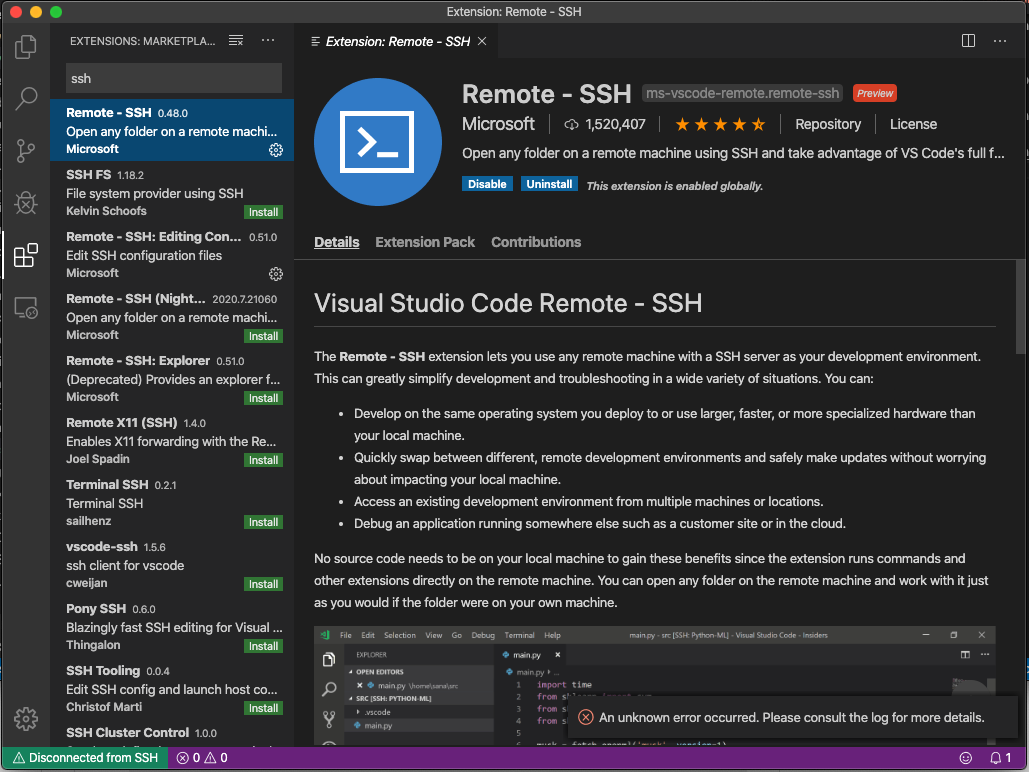Ever wondered how to securely connect to your RemoteIoT devices using SSH? Well, buckle up because we’re diving deep into the world of remote device management. Whether you’re a tech enthusiast or a professional in the IoT space, understanding RemoteIoT SSH examples is crucial for maintaining secure and efficient connections. In this article, we’ll break it down step by step, so even if you’re new to the game, you’ll walk away with all the knowledge you need.
Nowadays, IoT devices are everywhere—smart homes, industrial setups, and even wearable tech. But with great power comes great responsibility. Securing these devices from cyber threats is paramount, and SSH plays a critical role in ensuring that. If you’re looking to master RemoteIoT SSH examples, you’ve come to the right place.
Before we dive into the nitty-gritty, let’s quickly address why SSH is so important. It’s not just about connecting to your devices—it’s about doing it safely. Think of SSH as the digital lock that keeps your data secure while allowing authorized access. Ready to learn more? Let’s get started!
Read also:How Big Is A 9 Inch Pizza Unveiling The Size Slices And Savory Secrets
Table of Contents
- What is SSH?
- RemoteIoT Overview
- Why Use SSH for RemoteIoT?
- Basic SSH Commands
- Setting Up SSH on RemoteIoT Devices
- Security Best Practices for SSH
- Common Issues and Troubleshooting
- Real-World RemoteIoT SSH Examples
- Tools and Resources for SSH
- The Future of SSH in RemoteIoT
What is SSH?
SSH, or Secure Shell, is like a superhero for remote connections. It’s a protocol that lets you securely access and manage devices over a network. Whether you’re managing servers, IoT devices, or even routers, SSH has got your back. It encrypts all communication between your computer and the target device, ensuring that no one can eavesdrop on your data.
But here’s the kicker—it’s not just about encryption. SSH also provides authentication mechanisms to ensure only authorized users can access the devices. Think of it as a digital bouncer at a club, making sure only the right people get in.
Why is SSH Important?
In today’s interconnected world, security is a top priority. Without SSH, your data could be vulnerable to hackers, malware, and other cyber threats. By using SSH, you’re adding an extra layer of protection to your RemoteIoT devices, which is crucial for both personal and professional use.
RemoteIoT Overview
RemoteIoT refers to the practice of managing IoT devices from a distance. These devices can range from simple sensors to complex industrial machines. The beauty of RemoteIoT lies in its ability to streamline operations, reduce costs, and improve efficiency.
Now, when you combine RemoteIoT with SSH, you’re talking about a powerful duo. SSH ensures that your remote connections are secure, while RemoteIoT allows you to manage your devices effortlessly. It’s like having a personal assistant for all your IoT needs.
Benefits of RemoteIoT
- Increased efficiency in device management
- Reduced costs associated with physical maintenance
- Improved scalability for large-scale IoT deployments
- Enhanced security through SSH integration
Why Use SSH for RemoteIoT?
Let’s face it—IoT devices are everywhere, and they’re only going to become more prevalent. With that comes the need for secure and reliable ways to manage them. SSH offers several advantages that make it the go-to choice for RemoteIoT connections.
Read also:Chinese Calendar Year 1985 A Deep Dive Into Its Secrets And Mysteries
First off, SSH provides end-to-end encryption, ensuring that your data remains private and secure. Secondly, it supports robust authentication mechanisms, such as public key authentication, which adds an extra layer of security. Lastly, SSH is widely supported across various platforms, making it a versatile tool for managing different types of devices.
SSH vs. Other Protocols
While there are other protocols out there, such as Telnet, SSH stands out for its security features. Telnet, for instance, sends data in plain text, making it vulnerable to attacks. SSH, on the other hand, encrypts everything, keeping your data safe from prying eyes.
Basic SSH Commands
Now that we’ve covered the basics of SSH, let’s dive into some essential commands. These commands will help you get started with managing your RemoteIoT devices. Don’t worry if you’re new to this—by the end of this section, you’ll be a pro!
Here are some common SSH commands:
ssh username@hostname– Connect to a remote devicescp file username@hostname:/path/to/destination– Transfer files securelyssh-keygen– Generate SSH keys for authenticationssh-copy-id username@hostname– Copy public key to remote device
Tips for Using SSH Commands
When using SSH commands, it’s important to double-check your syntax. A small typo can lead to big problems, so take your time and make sure everything is correct. Also, consider using SSH config files to simplify your connections and save time.
Setting Up SSH on RemoteIoT Devices
Setting up SSH on your RemoteIoT devices is easier than you might think. Follow these simple steps to get started:
- Enable SSH on your device (usually done through the device’s settings or configuration files)
- Generate SSH keys on your local machine using
ssh-keygen - Copy the public key to your remote device using
ssh-copy-id - Test the connection by running
ssh username@hostname
That’s it! With these steps, you’ll have SSH up and running in no time.
Common Mistakes to Avoid
One common mistake people make is not properly securing their SSH keys. Always keep your private key safe and never share it with anyone. Another mistake is using weak passwords, which can make your devices vulnerable to brute-force attacks. Stick to strong, unique passwords and consider using two-factor authentication for added security.
Security Best Practices for SSH
Security should always be a top priority when working with RemoteIoT devices. Here are some best practices to keep in mind:
- Use public key authentication instead of passwords
- Disable root login to prevent unauthorized access
- Limit SSH access to specific IP addresses
- Regularly update your devices and SSH software
By following these practices, you’ll significantly reduce the risk of security breaches and keep your devices safe from harm.
Advanced Security Measures
If you’re looking to take your security to the next level, consider implementing advanced measures like SSH tunneling or port forwarding. These techniques can add an extra layer of protection to your connections and help safeguard your data.
Common Issues and Troubleshooting
Even the best-laid plans can go awry sometimes. Here are some common issues you might encounter when working with SSH and how to troubleshoot them:
- Connection refused: Check that SSH is enabled on the remote device and that the correct IP address and port are being used.
- Permission denied: Ensure that your SSH keys are properly configured and that you’re using the correct username.
- Timeout errors: Verify that there are no network issues or firewalls blocking the connection.
Remember, troubleshooting is all about patience and persistence. Don’t give up if you run into problems—chances are, there’s a simple solution waiting to be discovered.
Real-World RemoteIoT SSH Examples
Let’s take a look at some real-world examples of how SSH is used in RemoteIoT scenarios:
Example 1: Smart Home Automation
Imagine you have a smart home system with multiple IoT devices, such as thermostats, lighting systems, and security cameras. By using SSH, you can securely manage all these devices from a central location, ensuring that everything runs smoothly and efficiently.
Example 2: Industrial IoT
In an industrial setting, SSH can be used to monitor and control machinery remotely. This is especially useful for large-scale deployments where physical access to each device is impractical. With SSH, technicians can troubleshoot issues and perform maintenance without ever leaving their desks.
Tools and Resources for SSH
There are plenty of tools and resources available to help you master SSH. Here are a few of our favorites:
- OpenSSH: The most widely used SSH implementation, available for Linux, macOS, and Windows.
- Putty: A popular SSH client for Windows users.
- SSH Config Files: Simplify your connections by storing frequently used settings in a single file.
Don’t forget to check out online forums and communities for additional tips and tricks. The SSH community is full of knowledgeable individuals who are more than happy to share their expertise.
The Future of SSH in RemoteIoT
As IoT continues to evolve, so too will the role of SSH in RemoteIoT. With advancements in quantum computing and AI, we can expect even more secure and efficient ways to manage our devices. SSH will undoubtedly play a key role in this evolution, providing the foundation for secure and reliable connections.
Looking ahead, we may see new protocols emerge that build upon the strengths of SSH while addressing its limitations. Whatever the future holds, one thing is certain—SSH will remain a vital tool for anyone working with RemoteIoT devices.
Staying Ahead of the Curve
To stay ahead in the world of RemoteIoT, it’s important to keep up with the latest trends and technologies. Follow industry leaders, attend conferences, and continuously educate yourself on the latest developments in SSH and IoT. The more you know, the better equipped you’ll be to tackle any challenges that come your way.
Conclusion
And there you have it—a comprehensive guide to RemoteIoT SSH examples. From understanding the basics of SSH to implementing advanced security measures, we’ve covered it all. Remember, securing your IoT devices is crucial, and SSH is the key to doing it right.
So, what are you waiting for? Take action today by implementing SSH on your RemoteIoT devices. Leave a comment below if you have any questions or share this article with your friends and colleagues. Together, we can make the IoT world a safer place!

